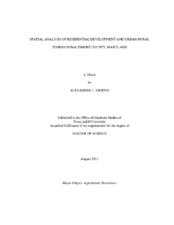| dc.description.abstract | Over the past half-century, Baltimore County, Maryland has experienced various policy measures that have shaped development patterns. This thesis analyzes three spatially explicit parcel-level models of residential development in Baltimore County to examine the effects of land-use regulations on multiple density classes from 1996 to 2008. The first model analyzes the entire county, while the second analyzes areas outside the county urban growth boundary, while the third model studied areas inside the boundary. While this region has been previously analyzed, prior studies have generally ignored policy affects upon the density of new residential subdivisions. The use of a binary dependent variable, i.e. develop or not develop, represents a critical oversight as this assumes policy measures exert a uniform impact across all development types. This study addressed this issue with the literature by using a multinomial logit model to differentiate the effects of various development policies to better understand residential growth. The objective of this research is to determine what factors influence individual landowner's decision to convert an undeveloped property to residential use. The impacts of rural conservation (RC) zoning and urban growth boundaries (UGB) comprise the prominent land-use regulations analyzed in this study.
The empirical estimates provided significant evidence that maximum density zoning effectively limits the density of new residential development in almost every model. Other policy measures, mainly rural legacy areas and critical areas, were generally found to be ineffective at limiting growth. This research concludes that maximum density zoning comprises the strongest tool for limiting development to a density mandated by the county government. Finally, maps depicting the predicted probability of development at two densities are included and discussed to indicate the areas most likely to be subdivided for residential land use. | en |


